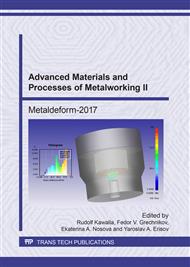[1]
B.L. Mordike, T. Ebert, Magnesium: Properties – applications – potential, Mater. Sci. Eng. A 302 (2001) 37–45.
Google Scholar
[2]
D. Letzig, J. Swiostek, J. Bohlen, K.U. Kainer, Magnesium wrought alloy properties of the AZ - Series, Magnesium Technology (2005) 55–60.
Google Scholar
[3]
S.R. Agnew, J.F. Nie, Preface to the viewpoint set on: The current state of magnesium alloy science and technology: Viewpoint set no. 47 Magnesium Alloy Science and Technology, Scripta Materialia 63 (2010) 671–673.
DOI: 10.1016/j.scriptamat.2010.06.029
Google Scholar
[4]
R. Kawalla, M. Oswald, C. Schmidt, M. Ullmann, H. -P. Vogt, N.D. Cuong, Development of a strip-rolling technology for Mg alloys based on the twin-roll-casting process, Magnesium Technol. (2008) 177–182.
DOI: 10.1016/j.matpr.2015.05.013
Google Scholar
[5]
S.P. Keeler, Determination of Forming Limits in Automotive Stampings, in: Mid-Year Meeting, SAE International400 Commonwealth Drive, Warrendale, PA, United States, (1965).
Google Scholar
[6]
M. Graf, M. Ullmann, R. Kawalla, Influence of Initial State on Forgeability and Microstructure Development of Magnesium Alloys, Procedia Engineering 81 (2014) 546–551.
DOI: 10.1016/j.proeng.2014.10.037
Google Scholar
[7]
M.R. Barnett, Influence of deformation conditions and texture on the high temperature flow stress of magnesium AZ31, J Light Met 1 (2001) 167–177.
DOI: 10.1016/s1471-5317(01)00010-4
Google Scholar
[8]
M.R. Barnett, Recrystallization During and Following Hot Working of Magnesium Alloy AZ31, Mater. Sci. Forum 419-422 (2003) 503–508.
DOI: 10.4028/www.scientific.net/msf.419-422.503
Google Scholar
[9]
A.G. Beer, M.R. Barnett, Influence of initial microstructure on the hot working flow stress of Mg–3Al–1Zn, Mater. Sci. Eng. A 423 (2006) 292–299.
DOI: 10.1016/j.msea.2006.02.041
Google Scholar
[10]
K. Neh, M. Ullmann, M. Oswald, F. Berge, R. Kawalla, Twin roll casting and strip rolling of several magnesium alloys, Mater. Today Proc. 2 (2015) 45–52.
DOI: 10.1016/j.matpr.2015.05.013
Google Scholar
[11]
A. Diehl, U. Engel, M. Geiger, Influence of microstructure on the mechanical properties and the forming behaviour of very thin metal foils, Int J Adv Manuf Technol 47 (2010) 53–61.
DOI: 10.1007/s00170-008-1851-4
Google Scholar
[12]
T. Naka, T. Uemori, R. Hino, M. Kohzu, K. Higashi, F. Yoshida, Effects of strain rate, temperature and sheet thickness on yield locus of AZ31 magnesium alloy sheet, Journal of Materials Processing Technology 201 (2008) 395–400.
DOI: 10.1016/j.jmatprotec.2007.11.189
Google Scholar
[13]
D. Rees, Factors influencing the FLD of automotive sheet metal, Journal of Materials Processing Technology 118 (2001) 1–8.
DOI: 10.1016/s0924-0136(01)01030-5
Google Scholar
[14]
Christina Krbetschek, Franz Berge, Matthias Oswald, Madlen Ullmann, Rudolf Kawalla, Microstructure investigations of inverse segregations in twin-roll cast AZ31 strips, Magnesium Technol. (Magnesium Technology) 2016 2016 369–374.
DOI: 10.1007/978-3-319-48114-2_71
Google Scholar
[15]
M. Ullmann, F. Berge, K. Neh, R. Kawalla, Development of a rolling technology for twin-roll cast magnesium strips, Metalurgija 54 (2015) 711–714.
DOI: 10.1002/9781119274803.ch71
Google Scholar
[16]
F. Berge, L. Krüger, C. Ullrich, Forming limit diagrams of twin-roll cast, rolled and heat-treated AZ31 as a function of temperature and loading rate, Mater. Sci. Eng. A 614 (2014) 27–35.
DOI: 10.1016/j.msea.2014.07.007
Google Scholar
[17]
F. Berge, T. Henseler, C. Krbetschek, M. Ullmann, R. Kawalla, Influence of temperature and loading rate on the forming limit behaviour of twin-roll cast, rolled and heat-treated AZ31 as a function of the stress state, in: Key Engineering Materials, 2016, p.67.
DOI: 10.4028/www.scientific.net/kem.684.67
Google Scholar
[18]
M.R. Barnett, Twinning and its role in wrought magnesium alloys, in: C. Bettles, M. Barnett (Eds. ), Advances in Wrought Magnesium Alloys Woodhead Publishing Series in Metals and Surface Engineering, Woodhead Publishing, 2012, p.105–143.
DOI: 10.1533/9780857093844.1.105
Google Scholar
[19]
M. Barnett, Twinning and the ductility of magnesium alloys Part I: Tension, twins, Materials Science and Engineering: A 464 (2007) 1–7.
Google Scholar
[20]
T. Al-Samman, X. Li, S.G. Chowdhury, Orientation dependent slip and twinning during compression and tension of strongly textured magnesium AZ31 alloy, Mater. Sci. Eng. A 527 (2010) 3450–3463.
DOI: 10.1016/j.msea.2010.02.008
Google Scholar
[21]
R. v. Mises, Mechanik der plastischen Formänderung von Kristallen, Z. angew. Math. Mech. 8 (1928) 161–185.
DOI: 10.1002/zamm.19280080302
Google Scholar
[22]
M. Ullmann, M. Oswald, S. Gorelova, R. Kawalla, H. -P. Vogt, Strip rolling technology of magnesium alloys, Steel Res. Int. (2012) 855–858.
Google Scholar
[23]
F. Berge, L. Krüger, M. Ullmann, C. Krbetschek, R. Kawalla, Anisotropy of the mechanical properties of twin-roll cast, rolled and heat-treated AZ31 as a function of temperature and strain rate, Materials Today: Proceedings 2 (2015) 233–241.
DOI: 10.1016/j.matpr.2015.05.020
Google Scholar
[24]
F. Berge, L. Krüger, H. Ouaziz, C. Ullrich, Influence of temperature and strain rate on the flow stress behavior of twin-roll cast, rolled and heat-treated AZ31 magnesium alloy, Transactions of Nonferrous Metals Society of China 25 (2015) 1–13.
DOI: 10.1016/s1003-6326(15)63572-5
Google Scholar
[25]
T. Al-Samman, G. Gottstein, Dynamic recrystallization during high temperature deformation of magnesium, Mater. Sci. Eng. A 490 (2008) 411–420.
DOI: 10.1016/j.msea.2008.02.004
Google Scholar
[26]
X. Huang, K. Suzuki, A. Watazu, I. Shigematsu, N. Saito, Effects of thickness reduction per pass on microstructure and texture of Mg-3Al-1Zn alloy sheet processed by differential speed rolling, Scripta Materialia 60 (2009) 964–967.
DOI: 10.1016/j.scriptamat.2009.02.022
Google Scholar
[27]
M.R. Barnett, A Taylor model based description of the proof stress of magnesium AZ31 during hot working, Metall. Mat. Trans. A 34 (2003) 1799–1806.
DOI: 10.1007/s11661-003-0146-5
Google Scholar
[28]
T.G. Nieh, et al., Superplasticity in metals and ceramics, Cambridge University Press, Cambridge, New York, (1997).
Google Scholar
[29]
S.P. Keeler, Application and forming of higher strength steel, J. Mater. Process. Technol. 46 (1994) 443–454.
Google Scholar
[30]
V. Hasek, Influence of different factors on the position and form of forming limit diagrams, in: North American Metalworking Research Conference and The Spring Meeting of ASME Production Engineering Division, 1973, p.35–48.
Google Scholar


